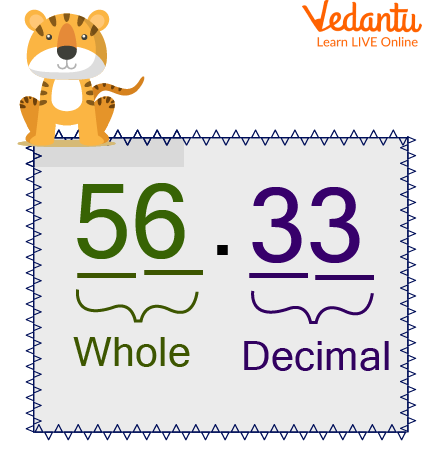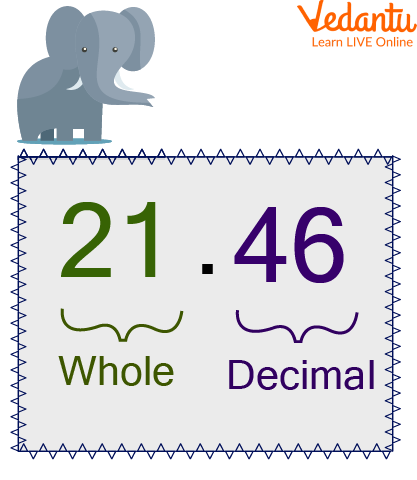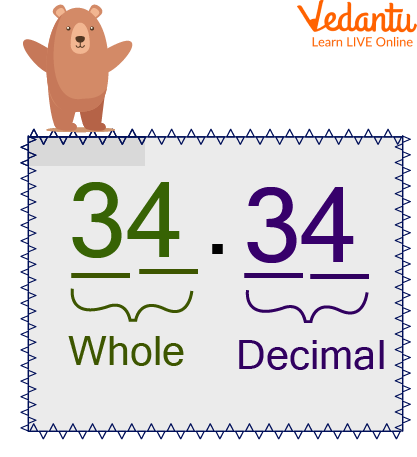




What is the Decimal Number System?
We have learnt that decimals are the extension of our number system. We also know that decimal numbers can be considered fractions with denominators such as 10, 100, 1000, etc. The numbers expressed in decimal form are called decimal numbers or decimals. This article discusses parts of a decimal number, along with decimal number examples. Some practice problems are given underneath for a better understanding of the topic.
For example, 5.2, 4.19, 11.83, etc.
Definition of Decimal Numbers
A decimal number is a number that has a decimal point between the whole number and the fractional part. The point is used to segregate these two parts of the decimal. Thus, it is called a decimal point. The numbers after the decimal point are always smaller than 1.
For example, in the decimal numbers 11.128 and 2.656, 11 and 2 are whole numbers, whereas 128 and 656, following the decimal point, are fractional parts of the number. The fractional part of the decimal number is smaller than 1. In the above examples, the fractional parts of the numbers are 0.128 and 0.656.
Parts of a Decimal Number
Generally, there are two parts of a decimal number:
Whole Number Part
The digits lying to the left of the decimal point form the whole number part. The places begin with ones, then tens, then hundreds, then thousands and so on.
For example, if we have to write the numbers two hundred one and 7 tenths numerically, then we will write it as 201.7. Here, 201 is considered a whole number.
Decimal Part
The decimal point, together with the digits lying on the right of the decimal point, form the fractional part of the decimal part; hence, it is always smaller than 1. The places begin with tenths, then hundredths, then thousandths and so on………
For example, 12.34 has .34 present in its decimal part.
Types of Decimal Numbers
There are two types of decimal numbers, namely:
Terminating
The decimal numbers have only a finite number of digits after the point or in the decimal part. These are also called exact decimal numbers. For example, 12.38, 2.39, 7.3, etc.
Non-terminating
In this type, decimal numbers have an infinite number of digits after the decimal point. Further, non-terminating decimal numbers can be classified into two categories, namely,
Repeating or Recurring Decimal Numbers: A repeating decimal or recurring decimal is a decimal representation of a number whose digits are periodic (repeating its values at regular intervals) and the infinitely repeated portion is not zero.
For example, 123.24242424…….
Non-repeating or non-recurring decimal numbers: These decimals are decimal fractions that will never end and, after the decimal point, even predictably repeat one or more numbers. Non-terminating repeating decimals are rational numbers, and we can represent them as p/q, where q will not equal 0.
For example, 124.1612014……
Decimal Number Examples
Q 1. Identify the whole part and the decimal part:
56.33
Ans: Whole part= 56
Decimal part= 0.33

Decimal Number Example
21.46
Ans: Whole part= 21
Decimal part= 0.46

Decimal Number Example
34.34
Ans: Whole part= 34
Decimal part= 0.34

Decimal Number Example
Practice Questions
Q1. Write the place and place value of the underlined digits:
(a) 8.13
(b) 53.31
(c) 100.92
(d) 11.381
(e) 0.004
Ans.
Hundredths
Tens
Tenths
Hundredths
Tenths
Q2. Express each of the following as decimals.
(a) $\dfrac{37}{100}$
(b) $\dfrac{11}{1000}$
(c) $\dfrac{9}{100}$
(d) $\dfrac{739}{10}$
(e) $\dfrac{1234}{1000}$
(f) $\dfrac{495}{10}$
Ans.
0.37
0.011
0.09
73.9
1.234
49.5
Summary
In this article, we have learned about the definition of decimal numbers, the parts of a decimal number, the types of decimal numbers, and how the decimal point is used to separate the whole part from the fractional or decimal part. Some decimal number examples are discussed to explain to the student the difference that arises in the placement of decimal points at different places. We also learned about the place value of the numbers in the whole number part and the decimal part of a number.
FAQs on Decimal Number System
1. What are the advantages and disadvantages of the decimal system?
There are many advantages of the Decimal Number System. First, they are easily readable and can be used by anyone. They are easy to manipulate and understandable too. However, there are disadvantages like space and time wastage. Digital systems like computers and hardware work on binary systems i.e. 0 and 1 number systems, there is a need for space to store the Decimal Number System.
2. What is a binary number system?
The computer system has an on and off switch at which it works on. These two are called the states and are represented by the digits 1 and 0. This 1 and 0 digit combination forms the binary number system. The numbers represent various data and since we use two digits which are used to show numbers, it is called binary number system. It has a base of 2 and is also known as the base 2 number system. The digits are multiplied with the appropriate power of 2 depending on the position.
3. What is bit?
Bit can be defined as the shorter version of the words digit and binary. It can be defined as the smallest unit of instruction or memory which is stored inside the computer or used for computer instructions. A bit can be either the digit 1 or the digit 0. They work on the binary number system which has a base number of 2.
4. What is byte?
Bit is the smallest unit of memory and instruction stored in the computer and a byte is a group of 8 bits. Bits can either be 0 or 1 and the byte is 8 in number so it can be written as 01100001 or something similar. A kilobyte has 1000 bytes which can be around one thousand letters approximately. Furthermore, 1024 kilobytes make a megabyte and so on.
5. What is hexaDecimal Number System?
In hexa Decimal Number System, we use 16 digits to represent numbers. They have the base number 16 and hence are also known as the hexaDecimal Number System or base 16 number system. The base number is greater than 10 and hence, letters are also used to represent this number system. The hexaDecimal Number System is composed of 0,1,2,3,4,5,6,7,8,9,A,B,C,D,E and F which is used differently. Using the alphabets in the number system is conventional and has no deductive reason.
6. What are Binary Numbers?
Computers can understand only two conditions “On” and “Off” i.e 1 and 0. The binary number system deals with the study of 0s and 1s.
A binary number system represents a number with the base 2, by using the digits 1 and 0. As it uses only two digits 0 and 1 and has a base of 2, it is called binary.
All electronic devices use a binary number system in their electronic circuit. The input 0 indicates the “OFF” state and the input 1 indicates the “ON” state. Because of these implementations binary number systems are used in modern computer technology.
Each digit is referred to as a bit.
There are no 2, 3, 4, 5, 6, 7, 8, 9 in the binary number system.
Example of the binary number system are:
1012
110012
7. What are Octal Numbers?
The octal number system is the numbers with the base 8 and uses digits from 0 to 7, the digits 8 and 9 are not used in the octal number system. The octal number system is also called the base 8 number system
The octal number system is generally used in a minicomputer.
Example of octal number system are:
4238
718
8. What is the other name for a decimal point?
A decimal point can also be called a decimal separator because it separates the decimal part from the whole part.
9. Is it possible to represent a decimal number to a fraction?
It is possible to represent a decimal number to its corresponding fraction. This is done by removing the decimal point from the given number and dividing it by the number of 10s as stated in the decimal.
10. What is the purpose of the decimal point?
It separates the whole number part from the decimal part.























